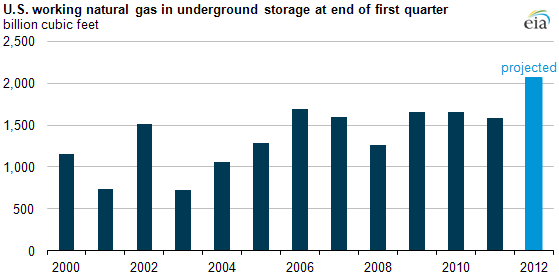
U.S. natural gas inventories at end of winter heating season expected highest since 1983

Download CSV Data
The amount of U.S. working natural gas in underground storage at the end of March 2012 is expected to be the highest since 1983 for the close of the month, the traditional end of the winter heating season. A combination of warmer-than-normal temperatures this winter that reduced gas heating demand and rising domestic gas production has contributed to high inventories.
This winter, warmer-than-normal temperatures reduced natural gas heating demand. Increasing natural gas production, especially in the Marcellus shale region, likely contributed to lower storage withdrawals as more gas supply in the Northeast reduced the need to bring up stored gas from the Gulf Coast.
According to EIA's February Short-Term Energy Outlook, working gas in underground storage is projected to total 2,066 billion cubic feet at the end of March, up 31% from a year ago (see chart above). This would mark the second time U.S. natural gas storage inventories topped 2,000 billion cubic feet at the close of winter and would put this year's inventories near the March 1983 record of 2,148 billion cubic feet.
High natural gas inventories at the end of the heating season could put downward pressure on wholesale natural gas prices, which have already declined this winter. Some storage operators may require their customers to withdraw their stored natural gas to ensure the reliability of the storage facility.
These required withdrawals could increase the supply of natural gas in the market; however, the circumstances will likely vary by region and company. Currently, storage operators reflect a wide range of inventory levels, and they have a variety of ways they can work with their customers to manage these inventory levels. In 2008, EIA issued a report indicating that contractual requirements for customers to reduce their end-of-season storage levels did not appear to be a major driver determining aggregate end-of-season storage levels for 2008.